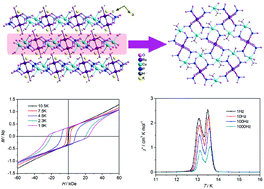Towards a new type of heterometallic system based on a paddle-wheel Ru2 dimer: first results derived from the use of a high spin diruthenium(iii,iii) building block†
Abstract
A new facile strategy has been reported for the synthesis of homovalent diruthenium(III,III) phosphates. On assembling the homovalent Ru2 units and Cu2+ in the presence of K+, new trimetallic phosphates, K2[{Cu(H2O)}2Ru2(PO4)4(H2O)2] (1), were formed. In compound 1, the Ru2 dimer showed a Ru–Ru double bond distance of 2.3400 Å with a high spin ground state S = 2, and neighboring [Ru2(PO4)4(H2O)2]6− units were linked via distorted tetragonal pyramid Cu(H2O)2+ ions, forming the negative layer [{Cu(H2O)}2Ru2(PO4)4(H2O)2]n2n−. Antiferromagnetic coupling was mediated between Ru26+ and Cu2+via O–P–O bridges. Detailed magnetism measurements demonstrated that compound 1 exhibited a two-step relaxation in oscillation susceptibilities, and an order below 14 K with a large coercive field of Hc = 24.9 kOe at 1.8 K. It is the highest Tc and Hc for the non-carboxylate diruthenium compounds reported to date.



 Please wait while we load your content...
Please wait while we load your content...